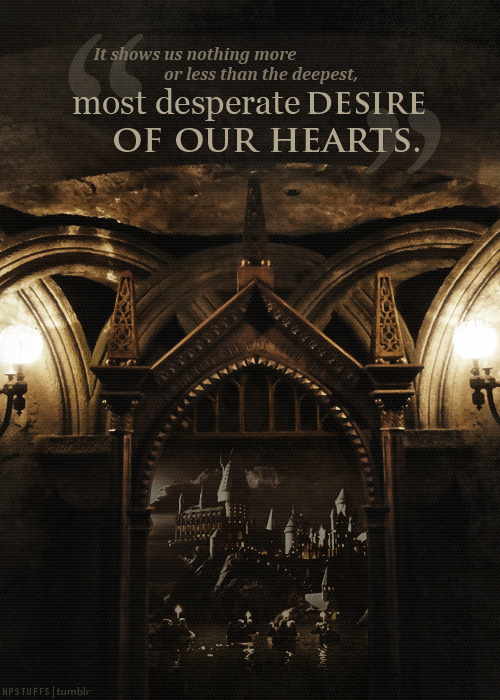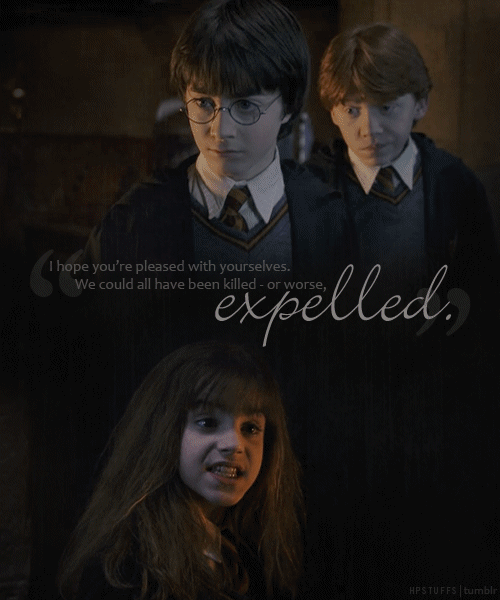*I do not own Harry Potter, therefore, mention of characters/concepts are solely intended for educational and therapeutic gain.*
In J.K. Rowling’s Harry Potter and the Sorcerer’s/Philosopher’s Stone, Harry Potter encounters the Mirror of Erised while sneaking around the castle in his inherited invisibility cloak. The inscription on the top of the mirror reads: “Erised stra ehru oyt ube cafru oyt on wohsi”, or when read backward, “I show not your face but your heart’s desire”. In other words, the mirror will show something different to each person standing in front of it. It shows the viewer his or her deepest desires.
According to Dumbledore: “The happiest man on earth would be able to use the Mirror of Erised like a normal mirror, that is, he would look into it and see himself exactly as he is”. It is not a bad thing to have dreams and wishes, however, in dwelling on them without action or self-love, they can become more detrimental than helpful. Therefore, the ultimate goal would be to look in the Mirror of Erised and just see yourself as you are. I do not think many people possess that level of life contentment, but I think with hard work, dedication, and openness, one can get closer to achieving that. Remember that the key to enjoyment is being in the present because living in the past causes rumination or sadness and living in the future instills anxiety and stress.
~
Please do the following visualization:
Imagine yourself standing in front of the Mirror of Erised. At first you notice just your reflection. Observe the outfit you have on, your face, body, and your facial expression. Now that you are focusing in front of the mirror, you notice that the view has changed. You see your deepest desires and wishes before your eyes. Are you like Harry, surrounded by deceased family members? Are you like Ron, a victorious quidditch captain, highly revered by others? Do you see yourself in a career? A relationship? Do you look different?
In a journal answer the following questions:
1. Describe what you see in the Mirror of Erised
2. How do you feel when you visualize the reflection in front of you?
3. Are there any surprises or shocks regarding what you see?
4. What would make your life better if you achieved the image reflected?
5. Can you without a doubt 100% guarantee that your life would be better? Explain.
6. What are some potential negative factors that could come from your deepest desire?
7. What are some potential benefits to keeping yourself exactly as you are?
8. Do you believe your dream is logical or attainable? Why or why not?
9. What are some perceived obstacles to achieving your dream?
10. What are some strategies or objectives you could implement to achieve your deepest desire?
11. If your reflection is not a possibility (for example, you are seeing a deceased loved one), what can you learn from your deepest wishes? Are there any ways you can incorporate it/them into your life? What might that look like?
~
Please follow this second visualization:
Now imagine that you have jumped ahead one year into the future. You return to the Mirror of Erised to see if your reflection has changed. Much to your surprise, it has changed, and you now only see yourself looking in the mirror with curious, determined, and confident eyes. Your body posture communicates strength, self-worth, and assertiveness. You know you still have flaws, but they feel perfectly suited to you, owning them with pride. You can’t make out exactly what your career, financial, or relationship status looks like in your life because you only see yourself. That uncertainty does not bother you, because you know that you still feel good about your life regardless of those circumstances. You also know that you can overcome any challenges or hurtles that come your way and will continue your growth process as a result.
1. Take some time to journal about your experience with this second visualization.
2. How did it feel to view yourself in this way?
3. What did you learn from this process?
4. What stands between the second reflection of yourself and the actual version you would see now in a muggle mirror (what is holding you back?)?
5. What can you incorporate from this exercise into your current worldview, attitude, and self-perception?
From this point forward when you look in a muggle mirror, you will envision your confident and positive self, carrying it with you everywhere you go.
Please note that these therapy exercises do not qualify as stand-alone treatments and it is recommended that you seek help from a licensed professional mental health provider.
Contact me with questions or to schedule an appointment:
E-Mail: jmorris@jmmhc.com
Voicemail: (248) 327-4643







Recent Comments